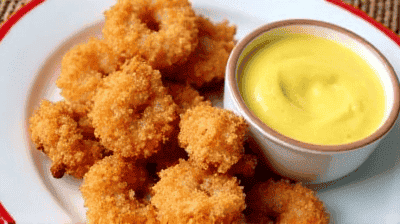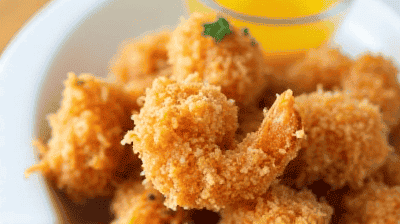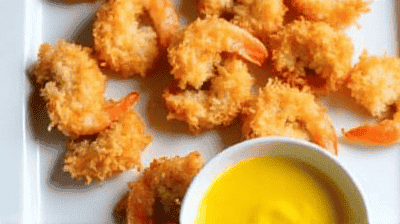
When it comes to appetizers, few options can rival the delightful flavor and texture of coconut shrimp. These crispy, golden bites are the perfect combination of crunchy coconut and succulent shrimp, making them an irresistible treat for any gathering. In recent years, the air fryer has revolutionized the way we cook, allowing us to achieve that satisfying crunch without the excess oil typically used in frying.
Coconut shrimp is a dish that combines the rich flavors of coconuts with the tender sweetness of shrimp. Originating from Southeast Asian and Caribbean cuisines, coconut shrimp is often featured in beach resorts and tropical-themed gatherings. The dish is characterized by its use of sweetened shredded coconut or panko breadcrumbs mixed with coconut flakes, which creates a crispy coating when fried.
Traditionally, coconut shrimp is deep-fried, which can lead to a heavy and greasy outcome. Using an air fryer allows you to achieve the same deliciously crispy exterior with significantly less oil, making it a healthier option that does not compromise on taste. The air fryer uses hot air circulation to cook food evenly and achieve the desired crispiness.

To create outstanding air fryer coconut shrimp, you will need to gather several key ingredients. Each component plays a crucial role in delivering exceptional flavor and texture.
Shrimp: The star of this dish is shrimp, preferably large or jumbo-sized. You can use raw shrimp that is peeled and deveined or frozen shrimp that has been thawed. Freshness is key, so opt for high-quality shrimp for the best results.
Coconut Flakes: For that signature coconut flavor, choose unsweetened shredded coconut or large flaked coconut. Unsweetened coconut offers a more intense coconut flavor, while sweetened varieties add a hint of sweetness.
Panko Breadcrumbs: Panko breadcrumbs are lighter and crispier than traditional breadcrumbs, providing excellent texture to the coating. You can mix them with the coconut flakes for added crunch.
Eggs: Beaten eggs are essential for binding the coating to the shrimp. This creates a sticky layer that ensures the coconut and panko mixture adheres properly.
Seasonings: Simple seasonings such as salt, pepper, and garlic powder are used to enhance the flavor of the shrimp. You can also add a pinch of cayenne pepper for a touch of heat if desired.
Mango: Fresh mango is the star of the tangy dipping sauce. Ensure that the mango is ripe and sweet for the best flavor.
Other Sauce Ingredients: Supplement the mango with lime juice, honey or agave syrup for sweetness, and a touch of salt for balance. Optional additions include chopped cilantro or minced chili for an extra flavor kick.
Now that we have familiarized ourselves with the essential ingredients, it’s time to prepare the coconut shrimp. Follow these steps for an effortless and enjoyable cooking experience:
Clean and Thaw (if necessary): If using frozen shrimp, thaw them in the refrigerator for several hours, or place them in a bowl of cold water for about 15 to 20 minutes. Once thawed, pat the shrimp dry with paper towels to remove excess moisture.
Peeling and Deveining: If your shrimp are not already peeled and deveined, carefully remove the shells and the dark vein along the back of each shrimp. Leave the tails on for a more appealing presentation.
Prepare the Breading Mixture: In a medium-sized bowl, combine the unsweetened shredded coconut, panko breadcrumbs, salt, pepper, garlic powder, and cayenne pepper (if using). Mix well to ensure the seasonings are evenly distributed.
Beat the Eggs: In a separate bowl, beat the eggs until well combined. This will create the binder for the coconut coating.
Coat the Shrimp: Take each shrimp and dip it first into the beaten egg, allowing any excess to drip off. Next, dip the shrimp into the coconut and panko mixture, pressing gently to ensure an even coating. Make sure each shrimp is fully covered in the mixture.
Rest the Breaded Shrimp: Once coated, place the shrimp on a plate or baking sheet. Allow them to rest for a few minutes to help the coating adhere better during cooking.

Now that the shrimp are breaded, it's time to take advantage of the air fryer to create that crispy texture without the guilt of frying. Follow these steps for perfect air-fried coconut shrimp:
Arrange the Shrimp: Arrange the breaded shrimp in a single layer in the air fryer basket. Make sure they do not touch each other to allow for proper air circulation. Cook in batches if needed.
Cook: Air fry the shrimp for about 8 to 10 minutes, flipping them halfway through the cooking time. The shrimp should be golden brown and crispy when done. Cooking times may vary depending on your air fryer model, so check for doneness.
No tropical appetizer is complete without a complementary dipping sauce. The tangy mango dipping sauce is simple to prepare and adds a burst of flavor that perfectly complements the coconut shrimp. Here’s how to make it:
Fresh Mango: Choose a ripe mango that is sweet and slightly soft to the touch.
Juice and Sweetener: You will need lime juice for acidity and honey or agave syrup to balance the flavors. Optional ingredients like chopped cilantro or minced chili can add depth.
Prepare the Mango: Peel the mango, remove the pit, and cut the flesh into chunks.
Blend: In a blender or food processor, combine the mango chunks, lime juice, honey or agave syrup, and a pinch of salt. Blend until smooth and creamy. Adjust the sweetness and acidity to your taste, and add optional ingredients if desired.
Chill: Transfer the sauce to a serving bowl and refrigerate for about 30 minutes to enhance the flavors and chill before serving.

The presentation of your dish can elevate the dining experience and make it even more inviting. Here are some creative serving ideas for your air fryer coconut shrimp with mango dipping sauce:
Create a colorful tropical platter with the coconut shrimp arranged alongside wedges of fresh pineapple, sliced kiwi, and vibrant bell peppers. This not only adds visual appeal but also complements the flavors of the shrimp.
Garnish your serving platter with fresh cilantro or parsley leaves. The bright green color adds freshness and enhances the presentation.
For a fun twist, consider placing the coconut shrimp on skewers. Alternate the shrimp with pieces of mango or bell pepper for added color and flavor.
Serve the coconut shrimp in individual lettuce wraps topped with the tangy mango sauce. This is a light and refreshing way to enjoy the appetizer, and it encourages guests to build their own wraps.
Use tropical-themed serving dishes such as coconut bowls or bamboo platters to establish a cohesive theme. This creates a fun atmosphere and transports your guests to a beach setting.
To create a complete tropical experience, consider pairing your coconut shrimp with refreshing beverages. Here are a few suggestions that complement the flavors beautifully:
Cocktails such as piña coladas or mojitos are perfect for enhancing the tropical vibe. The fruity flavors of these drinks work harmoniously with the sweet and savory notes of the coconut shrimp.
Consider serving a light and crisp white wine, such as Sauvignon Blanc or Pinot Grigio. The acidity in these wines can complement the flavors in the shrimp and the tangy mango sauce.
For non-alcoholic options, sparkling water with a splash of lime or a tropical fruit-infused drink will provide a refreshing contrast to the rich flavors of the dish.
While coconut shrimp can be indulgent, they also offer several nutritional benefits, especially when cooked in an air fryer. Here are some health advantages to consider:
Protein-Rich: Shrimp is an excellent source of lean protein, making it a great option for satisfying hunger.
Lower in Calories: By using an air fryer instead of deep-frying, you significantly reduce the calorie count and fat content of the dish.
Vitamins and Minerals: Shrimp is rich in essential nutrients such as vitamin B12, selenium, and iodine, which are important for overall health.
Healthy Fats: Coconut contains medium-chain triglycerides (MCTs), which may offer health benefits, including increased energy and improved brain function.
If you find yourself with leftover coconut shrimp or dipping sauce, proper storage is crucial for maintaining freshness. Here’s how to store and reheat them.
Air Fryer Method: To reheat, place the shrimp back in the air fryer at 350 degrees Fahrenheit or 175 degrees Celsius for about 3 to 5 minutes, or until heated through. This helps restore their crispiness.
Oven Method: Alternatively, you can reheat them in a preheated oven. Place the shrimp on a baking sheet in a single layer and bake at 350 degrees Fahrenheit for about 10 minutes.
Refrigerate: Store any unused mango dipping sauce in an airtight container in the refrigerator for up to a week.
Adjust Consistency: If the sauce thickens in the refrigerator, simply add a little lime juice or water and stir before serving again.
Air fryer coconut shrimp with tangy mango dipping sauce is the perfect appetizer for any occasion. It combines the tropical flavors of coconut and shrimp, enhanced by the vibrant taste of fresh mango, for an appetizing delight that is sure to impress your guests. The air fryer provides a healthier way to enjoy this classic dish, allowing for a delicious crunch without the added oil.
Throughout this blog post, we have explored the origins of coconut shrimp, step-by-step preparation instructions, creative serving ideas, drink pairings, and much more. By following the outlined recipes and suggestions, you can create a memorable dining experience that transports everyone to a tropical getaway.
So whether you are hosting a summer barbecue, a beach-themed party, or simply craving a taste of the tropics, air fryer coconut shrimp with tangy mango dipping sauce will undoubtedly become a favorite at your table. Gather your ingredients, fire up the air fryer, and prepare to savor the delightful flavors of this tropical appetizer delight.